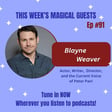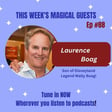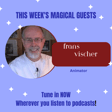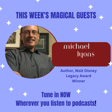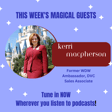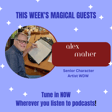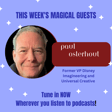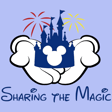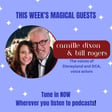Welcome and Introduction
00:00:01
Speaker
Welcome to Sharing the Magic, the podcast that sweeps you away into the enchanting realms of Disney. Each week, we're joined by a special guest, be it a magician casting real-life spells of wonder, or a Disney expert revealing hidden secrets in the heart of the happiest place on Earth.
00:00:21
Speaker
Together, we'll venture down glittering paths, uncovering tales of daring heroes, legendary places, and whimsical wonders that make Disney sparkle.
00:00:32
Speaker
So prepare to be enchanted, delighted, and transported to a place where dreams dance, fairy tales breathe, and the magic is real.
Meet the Hosts and Guest: Mindy Johnson
00:00:47
Speaker
Hello and welcome to the latest episode of Sharing the Magic. I'm your host, Barry, and tonight we have another fantastic guest joining us. But before we get into our wonderful conversation, let's say hello to our beautiful co-host tonight.
00:01:00
Speaker
First, we'll say hello to Dawn. Dawn, how are doing tonight? Hi, from Houston, Texas, and I'm really excited as a woman entrepreneur and can't wait to hear about how you highlight women, our guest today.
00:01:16
Speaker
All right, next we have Uncle Mike. He's wearing a weird weird hat tonight. We won't talk about it, but but we we'll let him say a few words. um How are you doing, Mike?
00:01:28
Speaker
I'm doing fantastic here in the Toronto Embassy at in Davenport, Florida. We just watched the Blue Jays go up two games to none on the Yankees in the AL Division Series. So let's go, Blue Jays, and I can't wait to have this conversation.
00:01:44
Speaker
And Barry is currently crying. I threw up a lot in my mouth that time. So, all right. All right. Next we have Angela. How are you doing tonight? Hey, everybody. I'm Angela. I am from Memphis and I am certainly excited to hear all about um women in animation. And I'm a Tinkerbell fan, so I know your background there.
00:02:05
Speaker
ah All right. Yes, it's going to be amazing. And um we have a wonderful guest, like I said, and I'm very excited to welcome Mindy
Mindy's Disney Beginnings
00:02:17
Speaker
Johnson. Mindy, how you doing tonight?
00:02:19
Speaker
I'm well. Thanks so much for having me, you guys. I didn't realize were going to on such an international or ah ah ranging call here. So how great. It's a joy.
00:02:31
Speaker
Yeah, wait we hit all the time zones here, I think. So, Mindy, so mindy the The question I ask each each guest each week is, well, for me, I think it's very important to hear.
00:02:47
Speaker
um so I'm excited to hear your your answer on this. And that is the question of how did you fall in love with Disney?
00:02:58
Speaker
I think by the same way a lot of people did every Sunday night, the wonderful world of Disney and my brothers and i it was a ritual. We ah have our TV trays set up and Tinkerbell set us off each week on a new adventure.
00:03:18
Speaker
And um that captivated me and
Career Path to Disney
00:03:24
Speaker
stayed with me. i think my first time, Feature film, animated feature film classic was Cinderella.
00:03:32
Speaker
ah or No, i take that back. My first was Mary Poppins. My first theatrical experience for a feature length film was Mary Poppins. i was a very, very young girl when that came out.
00:03:45
Speaker
But my favorite is Cinderella.
00:03:50
Speaker
So lots of fun there. And you can kind of tell by that answer, some of the foreshadow to my various books and projects and, and a whole array of things.
00:04:06
Speaker
And for our listeners that can't see her, she's a beautiful blonde wearing a Cinderella blue top. So dressed appropriate. I'm, I'm Disney bounding here in my colors. There you go. that's perfect.
00:04:20
Speaker
You know, Mindy, it's funny. you brought up the wonderful world of Disney I'm just sitting here because week after week, we have guests come on here and i tell you, i think nine out 10 say that the wonderful world of Disney somehow impacted their life. And I think, I think there's something about it because I remember as a kid watching it and being like,
00:04:48
Speaker
Oh, this is great. but But for me, it didn't have the the impact as it did on so many other people who who went into their livelihood doing that.
00:05:01
Speaker
um So what were some of the what were some of the programs or episodes that you you remember watching that kind of tugged at your heart?
Influence of Disney on Career
00:05:11
Speaker
Oh, you know, it it varied. it was For me, it was about Walt Disney coming into our home every Sunday night and the impact. I mean, I was very, very small when he passed, um but the shows kept running and The music, the the... I was never a Mouseketeer. I was a little too late for the Mouseketeer craze.
00:05:38
Speaker
But, um ah you know, just watching the oh films like Three Lies of Thomasina and The North Avenue Irregulars and you just some of the... We'd spend a lot of drive-in movie films experiences as kids and if there was a Disney film that was going to be in the summertime at the drive-in movie theater my mom would pack us all up in the car and it was a big night we'd get chance to you know go see a movie and it just never went wrong if it was a Disney movie it was always a great time
00:06:15
Speaker
So that's, I think, what also sparked my love of cinema and going to the movies. And at various points in my life, I found myself in the movie theater quite a bit.
00:06:29
Speaker
And I thought, there's got to be a way to make a living here. There's got to be a way to have a career with that. I was also very involved with music and um art. And it seemed I was very naturally capable in those areas, had talents that ah seemed logical to follow.
00:06:49
Speaker
But I was always fascinated with storytelling and filmmaking. And so that kind of carried through. and after pursuing a music degree and realizing I'd been I'm also a musician, so i i ben had achieved most of what I could do already, performing and professionally and ah with different ensembles. And and um I thought, there's got to be something to film. i
00:07:20
Speaker
An older brother had a darkroom in the house, so photography was fascinating. And so I found myself in the darkroom quite a bit and then thought, hmm, motion pictures, there's gotta be something there.
Highlighting Women in Animation
00:07:35
Speaker
And where do you go? I'm from Minnesota. So there's not too much going on there. Well, video was coming into play at that time. And so I was taking some classes, but um i had an opportunity to work in New York on a television series.
00:07:53
Speaker
It was my first job out of college. And I learned so much, you know, moving, you know, small town kid from Minnesota, moving to the Big Apple um and looking over the shoulders of some of the top people in television of the day and made me realize there's more I needed to learn. So I ended up applying to all the different film schools. One of the cast members on the show I was working on was also looking into um we were looking into and NYU together and other film schools.
00:08:27
Speaker
And I ended up applying all around and got accepted to the American Film Institute. So packed everything up from New York. And, you know, I thought, oh, I'll go when I um ride the show out for a while.
00:08:43
Speaker
And it was no, when you get in, you go. So I packed everything up, including my harp and moved across country to Southern California and started working at the American film Institute doing graduate work.
00:08:59
Speaker
And once that was completed, again, still following story and, and holding this tremendous love of classic animation. Those were magic.
00:09:12
Speaker
um So ah after film school finished, I ended up having a little bit of a ah medical situation where I needed to have a steady J-O-B so I could get a lot of jaw work finished.
00:09:29
Speaker
And I ended up getting a job at Disney. But it was a very corporate job and I was a little creative fish. So it helped to kind of, you know be in and have a nine to five that I could get to doctor appointments and get all this medical work managed. um And.
00:09:53
Speaker
But ah it still wasn't. answering what I wanted to be doing or telling stories. It was very, very corporate. So, and you know, gotta have that in order to keep the business going, but it just wasn't where I was meant to be.
Challenges in Uncovering History
00:10:08
Speaker
So I ended leaving the job only to come back. um It was sort of like returning to the mothership. and um But this time i was working in animation, TV animation.
00:10:23
Speaker
And ended up learning production, learning, working with artists, um a little more administrative, but but learning the nuts and bolts of ah production when there was what was called the TV animation division.
00:10:40
Speaker
And which is now, i think, still Disney Tunes. And met some incredible people there. And once jumped onto a production, once production wrapped, ended up landed over in Buena Vista Pictures Marketing, which was the theatrical marketing teams.
00:11:03
Speaker
And it's there that I started developing writing. which ultimately with different, we i worked on the original finding Nemo, I think was my first, um, premier event that we did. So it was working with the talent, you know, doing all the marketing, press relations, uh, press events, premieres, talent, handling, talent management, all of that.
00:11:30
Speaker
And I learned the ropes and had some terrific mentors there. and ah had a ball with it. And from there moved into home entertainment. And that's where handled the classic animated titles, did the global publicity for them, which is where I met many of our great legends, had the great joy of working with.
00:11:54
Speaker
But you need to find a new way to tell those stories to new generations. So it's always a joy when I get to um and at certain events of certain ages.
00:12:06
Speaker
I'm the one who, that these were my audience when they were three and four and five and six. And now they're in college and um you know starting careers on their
Overlooked Contributions of Women
00:12:18
Speaker
own. so But it's been great fun to see the people fruits of my labors i guess and uh get the stories out there and that's where i started writing my first book was when we were launching uh peter pan
00:12:39
Speaker
i don't want me to keep going or if you want oh yeah yeah uh so so who were um so who were some of your um The people that you looked up to before you got into, you know, deciding that you wanted to do motion pictures or before you decided you wanted to get into animation, was there people that you were you were trying to study to be like or people that you had had an influence on you to get into your craft?
00:13:09
Speaker
of the Sherman brothers and um you know that that blend of of songwriting and storytelling ah was tremendously huge. I remember as young kid, Mary Poppins, that's your first experience in a movie theater and but it doesn't get any better than that. And the brilliant music of the Sherman brothers And then fast forward how many years later, it was sort of a pinch me moment.
00:13:40
Speaker
One of my first campaigns on the Jungle Book garnered the opportunity to, you know place a phone call to Richard Sherman. Sure, come on over. Let's sit down and talk. It's the crown jewel. I'd love to talk about that film.
00:13:54
Speaker
So i'm I'm in the home of of Richard Sherman and one of my idols. And then later doing ah press events and then ah ah very became a very dear friend. Very, very dear friend. One of my sweethearts. I just, I miss him terribly. We would have the best, um you know, one of the best souls on the planet.
00:14:19
Speaker
Just adore him. So, ah That was a real you know full circle moment. In fact, the same billing for Mary Poppins was a Winnie the Pooh short.
00:14:37
Speaker
And I can't recall if it was Blustery Day, probably Winnie the Pooh and the Blustery Day. And I fell in love with this little cartoon character named Christopher Robin.
00:14:49
Speaker
ah you know four-year-old me it's like oh who is this enchanting little boy and my gosh well again and then coupled with the magic of mary poppins and i mean it was just this i thought i'd entered into ah you know through through narnia um And the theater itself was just this magic place and this magic experience.
00:15:17
Speaker
And so again, fast forward couple of decades and I'm gearing up with my international press event for jungle book. And I have Richard Sherman and Bruce Reitherman.
00:15:33
Speaker
Bruce Reitherman had been the voice. He was the son of Wooley Reitherman is the son of was, and, um, was the voice of Christopher Robin in that particular way, the Bouchard.
00:15:47
Speaker
So I'm standing outside of our location and I get my talent in and I've got, you know a little bit of ah catering there. So why don't you go in and get a cup of coffee and get a bite to eat before we get underway. And I'll, you know, and I stop after I send them on their way and I look over and there's Bruce Reitherman and Richard Sherman sitting at a table, catching up and, you know, talking to each other.
00:16:09
Speaker
And I had to stop fast and just go, oh, my gosh, if you would have told me when I was four years old that I was going to be Now, you know, handling or working directly with the two men who had a very large hand
Research into Women's Roles at Disney
00:16:26
Speaker
of two of the three men, Walt Disney included there, ah had a lot to do with me falling in love with the movies. You know, it was a real pinch me moment.
00:16:37
Speaker
but And one of those classic... magic dig Disney moments. And then ah years later on the Princess Bride films, I worked with Julie Andrews, um Dick Van Dyke, you know, all of my Mary Poppins trifecta is coming through.
00:16:56
Speaker
So um it's been a real... again, just a joy. And I i i don't take it lightly either. i i It just affirmed, okay, I guess I'm where I need to be. I guess I was doing what I needed to do at the time. and it's placed me on the journey to where I am now.
00:17:16
Speaker
And the research and the books that I do and the stories that I tell in my own crazy unique way. And so it's been quite a journey.
00:17:27
Speaker
You know that saying, um do what you love and you'll never work a day in your life? I mean, you have pretty much summed that up, at least for me.
00:17:39
Speaker
That is amazing. Well, there been some long days of work, that's for sure. But you love it. And so that's what makes it worth it. And I think when you look for what you love about it,
00:17:51
Speaker
There's going to be tough days. There's going to be personalities you may or may not get along with. There's going to be twists and turns. um It's been a very circuitous path. It's not been a straight, you know, some people know that they're going to, you know, pre-med and then med school and then internship and then residency. And then, you know, they've got it mapped out.
00:18:12
Speaker
And that's great. um As a creative person, I, It has, there's been a path there if you look back on the course, but there's no way I could have ever imagined or figured this.
00:18:27
Speaker
Writing was the last thing on my list. um But now that's, it's you know i'd love I love when I can make the world go away and just dig into the research.
00:18:39
Speaker
And I love seeing the reaction and the impact that it has, the change that it initiates. um the difference it makes in people's lives.
00:18:50
Speaker
So yeah, i I feel I'm grateful and I feel blessed. um On that path, let me ask you, what initially inspired you to dedicate so much time into the research of the the women in animation? Because it seems like your heroes or what people that led you down that path were all, you know, male figures.
00:19:11
Speaker
So how did you get into pursuing the other side to inspire that change? thats That's a good question. Again, kind of like working for many years at Disney Studios, I heard the stories, knew the, ah you know, oh, it was pretty girls who traced and colored.
00:19:27
Speaker
Wow, how great. How charming, you know. or ah yeah there were three women. You heard whisperings of Mary Blair, maybe Reda Scott, and maybe ah Lillian and Edna Disney, but that was it.
00:19:43
Speaker
know, like there were five women who worked at the studio. And um so, and that had been prevalent all along. I mean, God bless Dave Smith for his efforts in the archives.
00:19:56
Speaker
But when I... when we first pitched this book, we all thought it was going to be a charming, the ink and paint book. We thought it was going to be a charming little book on pretty girls who traced and colored. And um so we, my editors and I talked about, yeah, the tea cakes and the tunnel of love and the social dating and mating, and it'll be fun. It'll be a fun book.
00:20:23
Speaker
And I got about six months into the research and had a something kind of along the lines of a panic attack. It was an avalanche of, you know, when you start scratching at something and then you you learn the, whole oh holy cow. um I couldn't get my head around it. We thought it was going to be from the beginning of the studio to today.
00:20:48
Speaker
and it was epic. And i could not get my head around what exactly what ink and paint it entailed. um The volume of what they were doing, um it just slowly started unfolding. And again, six months in it hit like a ton of bricks.
00:21:07
Speaker
And I called my editor in sheer panic and said, this epic. And what these women accomplished, no one has covered. You go to any book on the shelf by many of my brethren who their work is great, but you go to the index and you see the same five women.
00:21:28
Speaker
Again, Mary Blair, Reda Scott, Lillian and Edna, maybe Margaret Winkler. And if it's Margaret Winkler, she's maligned. um And I just thought, wait a second. And it took ah an emergence for me to recognize history is in fact recorded, written about, preserved, archived and documented from a male perspective.
00:21:55
Speaker
And again, God bless Dave Smith for what he did. But when I first walked in and said, okay, I'll need, I was familiar with the publicity efforts. So let's start there for various films.
00:22:07
Speaker
And I'll need to look at, um let's go to Walt and Roy's Ledgers because it was very materials based. So where did they get the paint? Where did they get the cells? And so I'll need everything on the films, everything on the ledgers, and then everything ah on women and ink and paint. So with the films, I had boxes of things to go through, no problem.
00:22:30
Speaker
On the ledgers, there were stacks of ledgers to go through from the very beginning. And I will never forget that amazing archivist face when he walked out of the back room and he said,
00:22:42
Speaker
This is all we have on women in Inca Payne. And it was a folder that had five pieces of paper in it. That was it. And he was stunned. Just his mouth was agape. And I went, okay.
00:22:57
Speaker
um At that point, I was aware.
Future Projects on Women's History
00:23:00
Speaker
No surprise. um So it's very different now. They've got quite a few things thanks to the work I've been doing.
00:23:09
Speaker
A few things we need to keep correct. There have been a few people who are attempting to write about this area that are no idea what they're told. They don't know what they don't know. so they're making some false assumptions and perpetuating myths that have been corrected.
00:23:28
Speaker
But um it it um never ceases to amaze. Let me put it that way. And I had no idea... ah um ah Really, nobody did. Someone else may have come along a few years later.
00:23:46
Speaker
and But I was, had I started even five months sooner, we had ladies dropping, ah ah sadly. And I was able to get the last couple of women who had worked on Snow White,
00:23:59
Speaker
um i was able to get i think i did like 180 interviews for that book and um they're you they're logged in the back the books yeah take a look uh but the ah just the immensity of it the weight of it and i had to several times call my editors and go okay i don't know where this ends And at the time when I called in my panic state, my editor said probably the the best thing she could have said and the scariest thing she could have said, which was, i said, this is epic.
00:24:37
Speaker
I don't know where it ends. Nothing has been done on this. And I'm in a panic. And she said, okay. keep going, which was a relief and the scariest, I don't want to get too base here, but it was dang, that was scary. And i you hear about the nine old men, but there's no nine old women that they talk about. There's like 900 nine old women. There are so many incredible women whose work had gone completely unnoticed. And
00:25:17
Speaker
As large as that book is, that is still only scratching the surface. I could have been doing multiple
Correcting Disney's Historical Narratives
00:25:23
Speaker
volumes. And the new book that I'm working on, which hopefully will be out next year, I keep making new discoveries.
00:25:32
Speaker
It will be out next year. sort of sister volume to Inca Paint. is is sort of a sister volume to incapa where And it was important on Ink and can Paint to tell the stories, not only of Disney, but other studios.
00:25:51
Speaker
But that's just a tiny micro surface. Again, The new book is an inverse of that. You will get some new Disney elements, but um it's every other studio and from pre-cinema to the nineteen thirty s early they say.
00:26:10
Speaker
so um stay tuned as they say And I think, I mean, you hit the nail on the head because this is exactly what this podcast is about, because we um we're trying to go out of the way of finding the people behind the people because it's important. and what you have written and also the the book um on the women of Imagineering, I think these two books are very important because
00:26:43
Speaker
It's time for them to be recognized. Don, you always say this. It's time for for people to, I mean, that they get recognized for their achievements, for their for their role in making Disney what it is today.
00:26:56
Speaker
And a lot of times we're looking at it and being like, okay, yes, yes, we all know the nine old men. Great. But they didn't do it by themselves. They had people working behind them.
00:27:08
Speaker
Those people had people working behind them because if you look at you look at every single movie or every single attraction or anything that has to do with Disney, it's not one person doing it. It's a group group of people. And especially when you when you brought up, you know you know, yeah, we're always talking about the same old, same olds, but the same old, same olds are just that.
00:27:34
Speaker
They're the same olds. They're not everybody. Yeah. I had an instance also in the archives where another colleague who has written some notable books and I hadn't met him at that point, ah came in and didn't realize he was talking to me and started kind of lambasting because word was out while I was working on InGabBaint that how dare she talk about, i heard she's covering our topic and how dare she do that? And i'm like,
00:28:06
Speaker
Finally, i had to sort of fess up. I'm the Mindy Johnson you're talking about. And I said, oh, oh, well, which films are you coming Well, all of them, because the women worked on everything.
00:28:20
Speaker
And the mindset was at that point, you know, again, Reda Scott, Mary Blair, no nothing else, nothing to see here. Pretty col girls are tracing color, no big deal.
00:28:32
Speaker
Color by number. oh No. And I take immense joy in, like, if you've seen Don and um Chris Merritt's new book, Don Hunt, The Happiest Place on Earth.
00:28:50
Speaker
And these guys covered the ladies. God bless them for doing that. Where before it would have been a book about all the men and maybe you would have had a reference to Mary Blair on Small World and a couple of murals or you you know maybe a ah mention of Alice Davis or...
00:29:11
Speaker
you know, the work or Harriet Burns, maybe. ah Finally, finally, finally, my brethren and others are recognizing because there's a place to go to now, a starting point to say, oh yeah, we should be talking about the women as well because they've been there, always have been there in the room.
00:29:30
Speaker
And we've, we've failed. We as a society have failed to, and we've overlooked, it's that an unconscious bias and their contributions are not to be taken lightly.
00:29:44
Speaker
ah Margaret Winkler, we would not have anything Disney if it wasn't for Margaret Winkler. And she's been so wrongly maligned and and ah painted as a villian villain. And she wasn't, she wasn't at all.
00:29:59
Speaker
She was brilliant. She knew her stuff. And um again, some of my brethren just, well, it's a woman. What does she know? She's telling Walt Disney how to make his films.
00:30:11
Speaker
She had been distributing for years and knew the industry, knew what audiences wanted, had been in the theaters listening to them and recognized and knew what worked and what didn't.
00:30:22
Speaker
And Walt was this young novice who had made a film, a few films in Kansas City, went bankrupt and was coming out to Southern California to try to start again.
00:30:33
Speaker
He paid attention. he listened. If you read that correspondence, he's listening.
Creative Impact of Women at Disney
00:30:39
Speaker
And we wouldn't have where we are today if it wasn't for her. She single-handedly made animation a standard part of the movie-going experience.
00:30:47
Speaker
She was a key part of making, ah creating kind of the consumer product side of things with Felix Agat. Her work is incredible. And yet she is... sadly getting lost unless we can turn that around.
00:31:03
Speaker
so in my classes, in my lectures, in my books, that's what I do is get that balanced. um When UCLA reached out to have me teach there, i it's one of their more populated classes because it's open campus-wide.
00:31:20
Speaker
We have about 200 students, 180, somewhere between students. in a Bale lecture hall. And I'd said, listen, and I'm kind of books, but I'd like to make this work. But if i if you need someone, I can refer about a half a dozen people, but you'll get the dead white guys. And we love them. Their work is great.
00:31:43
Speaker
But there's so much more to this. And if I'm teaching it, you will get the most balanced approach, meaning you're going to find out about the women and other underrepresented artists who were vital in shaping. Animation is one of the most diverse art forms because it wasn't about your hair color or your shoe size.
00:32:04
Speaker
It was about your artistry. And that's what counted definitely at Disney. So when
00:32:12
Speaker
researchers come along who want to be writing books about this area. ah Unfortunately, there are a couple of abysmal books out there that you really need to stay away from. And yet,
00:32:25
Speaker
They get referenced all the time and they're riddled with problems. So um i think you have to be mindful and careful when you're researching. Check your sources and check the the validity of what, you know, the credibility of it all.
00:32:42
Speaker
ah Someone who's never worked in animation, who doesn't understand the industry, it's going to show up in their work. And so they're just re-
00:32:53
Speaker
repeating what other people have done who have not really checked. Oh, it's in print. It must be form must be official. Well, no, it's not. And so there's a lot of um work that has to be corrected.
00:33:08
Speaker
And that's a large part of what I'm up to these days. So. I want to just say thank you for your work and your dedication for this, because i like without you, we wouldn't know.
00:33:21
Speaker
And Barry picked the perfect month. This is breast cancer awareness month. Women, women in power, you know, pink, and all of that. So I'm so glad the timing was perfect.
00:33:36
Speaker
yeah Yeah, it's it. Well, it's always the right time to talk about our women, but absolutely this month, that especially for Barry picking. Yeah. Well done.
00:33:47
Speaker
Well done. So what do you. Oh, go ahead. No, go ahead. Go. I was just going to ask, what do you think some of the biggest challenges were for the women at the time in that in a male dominated industry?
00:33:59
Speaker
and You know, it is kind of both books are words and all. But it isn't quite as devastating as a lot of the myths paint it.
00:34:10
Speaker
There's that dreadful Snow White letter that says women didn't do anything. Women don't do anything creative and ah But when you and so people sort of quickly throw that up because it's low hanging fruit.
00:34:24
Speaker
When I came across it, I thought, this doesn't smell right. Something's up. It's a little too on the nose. And in going through the archives, we got to the bottom of that letter.
00:34:37
Speaker
And at the time, it's the height of the depression.
00:34:42
Speaker
And the little studio was ah was kind of a boomtown in Hollywood because people were working. You felt like you won the lottery. You had a job. You worked hard.
00:34:53
Speaker
It was hard work, but fun work. And um you could make a decent living. Listen, $15 a week, you could rent a lovely two-bedroom apartment in Hollywood for $15 a month.
00:35:09
Speaker
So you were doing quite well. And if you had a roommate, you're even better. You could buy a ah ah very capable used car for like $400. um You could buy a can of beans for two cents.
00:35:26
Speaker
ah it's You have to contextualize this stuff. And so when people write about, oh they were paid so terribly, and you have to contextualize, you have to dig further.
00:35:39
Speaker
And so when you read that letter, um the woman is living, that it's sent to is living in, um want to say Maryland or Baltimore. It's back east somewhere.
00:35:51
Speaker
And um they couldn't have, it's the depression. The studio didn't pay for artists to move to Southern California. They worked to find their artists locally because it was a major endeavor to pack up and move.
00:36:07
Speaker
And when when People from all over the world were sending in portfolios or sending letters trying to figure out how they could get a job working in cartoons. Because it looked like fun, right?
00:36:24
Speaker
They needed to initiate what was kind of a polite thank you but go away letter. So it was created out of it was an administrator, Mary Bream, who signs it.
00:36:35
Speaker
She was a secretary. And literally you didn't have to do it in those days. We don't do it so much today. you know, you put your resume in a file online and you never hear anything, right?
00:36:50
Speaker
So back then people were much more polite, much more cordial about it all. So in the piles of materials they would get on a regular basis, she would send out these form letters. If it was anything coming from out of state, they got the Thank you, but you know light go away.
00:37:11
Speaker
Sorry, women can't, they shut it down. So it reads very horrific, right? But women who were working there, I've seen in the collections, other private collections, Rae Medby McSpadden, she grew up in Northern California and she knew as a kid that's what she wanted to do.
00:37:31
Speaker
The day after her graduation, she had family living in Southern California. She had written to the studio and said, i am moving down to Southern California. What do I need to do? I've studied art. What do I need to do?
00:37:44
Speaker
Her letter reads very differently. Okay, thank you very much for your query. you know, it's Tuesday mornings, we review portfolios, come in on, you know, bring us your stuff and show you, show us what you've got.
00:37:59
Speaker
And people who don't know what they don't know think that ink and paint is nothing but pretty girls who are tracing color, nothing creative to see here. It was far more creative than are lovely brethren with pencils that have erasers.
00:38:15
Speaker
Just as much, if not more creative. And that's what was so difficult to get my head around because you're working on a rubric level. These women were trained in fine art.
00:38:27
Speaker
The training they got was in applying that fine art to animation. Even animators in-betweeners were getting trained. And many were comic artists or illustrative artists or fine artists.
00:38:41
Speaker
But That was the case with women as well. And because no one has been writing about this all this time, we focused on our men, their work is great, but every book going back to the Fields book, which came out in the ah fortyties i think, thirty s late thirty s forty s which does a fairly in-depth dive, is pretty minimal to what unfolds in the ink and paint side because it's such a rubric of cell levels and color levels and color artistry and then developing their own paints.
00:39:18
Speaker
Mary Weiser, know, they'd have problems. ah If it was too hot outside, the paint would never dry. If it was too cold, it would dry too fast. Wouldn't hold suspension. It wouldn't blend properly. So it starts separating.
00:39:32
Speaker
flaking off, cracking. um You know, if it was too hot, they were sweating on the cells. So the ice cream guy made a bang up business that day, right? Roy would pop for ice cream for everybody because it was so hot.
00:39:46
Speaker
You know, they had to pace their timing. They didn't have air conditioning in the buildings. So in 1935, when they they designed their new state-of-the-art inking and painting building, at the Hyperion Studio, it was one of the first buildings in west of the Mississippi to have air conditioning.
00:40:04
Speaker
Not so much, yes, to keep the ladies comfortable, but it was about meeting the paint quality so that you could have climate control and you could get the work done consistently. You weren't waiting for paint to dry or having to redo things because it dried too quickly or puddled weirdly and you had to redo a scene.
00:40:22
Speaker
So Walt would invest and he invested in the women and invested in their work and saw the level of artistry. And ah it is still baffling to me how we've looked past their work.
00:40:40
Speaker
And I can't tell you how many panel events and even my own campaign sometimes focused on getting the the men with pencils. But we've looked past, look at that great animation. Isn't that beautiful? And you're looking at like Fantasia or the old mill and that beautiful Rembrandt-esque color.
00:40:58
Speaker
And we, oh, it's all about the multi-plane. Wait a minute. Look at the color that was achieved and how the women got that. We've all looked past it. We've all been unconscious to it until I started talking about color and where women elevated the artistry.
00:41:18
Speaker
You know, Mary, people would talk about color associated with Mary Blair. Absolutely. She took us to a new level, most definitely. But listen, that had been going on decades prior.
00:41:30
Speaker
Even moving the advent from blackening in the early Oswald and Alice comedies to when Mickey and Minnie came along with panchromatic film stocks, suddenly you could work with black, white, and three or four shades of gray. So that gave you an entirely new dimension to these characters.
00:41:48
Speaker
So it wasn't even so much about the charming characters because we'd had mice that for years um before, which in the new book you'll learn there was a woman who developed the first animated mouse couple ah about nine years before Mickey and Ninny, and it was at another studio.
00:42:08
Speaker
But With the advent of of new film stocks, Walt jumped into that, and it was Hazel Sewell and her teams that cultivated this new visual quality to the Mickeys and Minis versus everybody else still blackening in, just black and then white in the background.
00:42:29
Speaker
So it was the women who gave it sophistication. It wasn't, but yet everybody credits Mickey and the characters. Well, we've had mice romping around on the screen all this time.
00:42:41
Speaker
There was a new look, a new quality, and Mickey and Minnie made that difference. So we're just balancing out. We're finally getting the collected other half of our animated experience that nobody else talked about.
00:42:58
Speaker
And it's making a difference.
00:43:02
Speaker
think that that kind of transitions well
Walt Disney's Progressive Relationships
00:43:06
Speaker
into my question. So ah Walt Disney, he's often remembered as a visionary. I think that's that's ah oh correct way of looking at him.
00:43:14
Speaker
ah But your work shows us there was this great team of women behind him, artists, inkers, painters, designers, who helped bring his ideas to life. um From your research, how did Walt really view and work with the women at his studio? And do you think that his history with women in animation is more complicated than people might realize?
00:43:37
Speaker
No, I don't. I think he was highly supportive of the women. ah As I mentioned earlier, there's a particular book out there that is quick and easy to read. And that's easily more tempting than my tiny tome. But...
00:43:53
Speaker
It is riddled with problems. If you are on a quest to tell a certain story, you can go out and find all sorts of things to support that thesis, right? And that's the way a lot of researchers are taught.
00:44:07
Speaker
Start with a thesis, start with your idea, and then find things to support that idea. When I go out, when I start a subject, i am wide open. I have no judgments at all.
00:44:19
Speaker
And I knew i was going to tell a warts and all book. And I was
00:44:29
Speaker
pleasantly surprised because I'd heard the stories of, oh yeah, they just pulled women off the streets and they were coloring by number and they were treated terribly. And I.
00:44:41
Speaker
When you search, when you keep that open mind and you're exploring all areas and you work to contextualize, I'd ask that question to many of the women who sadly are now gone.
00:44:53
Speaker
And they said, you know, ah we loved working for Walt. it was it It was a different time for women. You didn't talk about what women did. Women weren't expected to be, oh, oh no, no, that's okay.
00:45:08
Speaker
um Society was very different. ah And again, that's why I contextualize in the book that women were breaking records, but for example, Grace Huntington, she had worked in story at the studio.
00:45:24
Speaker
She wasn't so much an artist, but she was developing story ideas. and researching ideas. People have called her an animator. People have called her a story artist. She wasn't.
00:45:35
Speaker
People have credited her with artwork. No, those were gifted to her. Again, these are people who don't know what they don't know. oh well, it's in her collection. It must be her drawing. Oh, could you read the Roy Williams down in the lower corner?
00:45:49
Speaker
now um So people make some sweeping, uneducated assumptions sometimes. Occasionally in research, you have to take a leap. But um boy, if you don't know what you don't know, it can be a hot mess.
00:46:04
Speaker
And that's the case in, well, I'm thinking of one book in particular. And as a result, a number of papers and books and online articles that are riddled with problems because people are using that book and relying on the problems. So to answer your question though, Walt had a huge respect for women.
00:46:28
Speaker
It's why ah what stood out for me in my research when I found the article of what I know about girls or what I know about women, which opens the book.
00:46:38
Speaker
And it's this charming article where he talks about being a girl dad, pretty much. And when you look at his youth, I begin with the women who populated and had major influence on his youth growing up.
00:46:55
Speaker
um His mother and his grandmother, in introducing him to the fairy tale art form, and his aunt who bought him his first pencils and encouraged him to be drawing.
00:47:08
Speaker
um he surrounded himself with women. you know, he had daughters. He loved Hazel, his sister-in-law, lived with them for a while and her daughter. you know, and he would joke about being henpecked, but he loved it. And many people I talked reaffirmed that.
00:47:28
Speaker
And I think he held women. There are a number of quotes incorporated where he talked about women being the tastemakers. ah in terms of making the choices for what movies the families would see, what they would be buying, where they'd spend their money.
00:47:45
Speaker
He had a lot of respect for women. Where these myths have been coming about, ah there were gags that were pulled in the rooms.
00:47:56
Speaker
I know Bianca Mazzoli had a little bit of difficulty with, she was brilliant artist and did a lot of incredible work. But when you get somebody writing an article about how, oh, she was overlooked and bypassed and nobody did anything and the men were terrible to her, she was uncomfortable.
00:48:16
Speaker
I've been, how many times, ladies, have you been the only woman in the room, right? We've all been there as women. And it can be a little challenging.
00:48:27
Speaker
I was raised with three brothers. So I learned to be a little, right, get along or, you know, joke along with, or be one of the boys or whatever it took. But even then I've had challenges where um you're the only one of a kind in a room and it's still difficult. There's still those unconscious biases and tendencies.
00:48:50
Speaker
But again, ah I challenge any sort of, oh it was Disney and the suppressive environment. I challenge that because there are countless email or um emails well emails of the memos that would have gone around that said, gentlemen, watch your language. Walt wants this to be a comfortable place for the ladies to work.
00:49:10
Speaker
yeah There are countless problematic books where people go, oh, the women were funneled into the ink and paint and they never got any attention. That's not true. Hazel Sewell said, because it was men and women at Disney and at other studios, men and women were in inking and painting.
00:49:30
Speaker
was kind of part of the overall hierarchy. But Hazel Sewell, who was running the department, said, do you know, the women are better. And I want them to feel comfortable because the men would be shooting rubber bands and, you know, throwing notes and tossing things over the walls. And and Hazel was like, you know what?
00:49:52
Speaker
We got work to do. let's And the women are better at it. We've got to be more exacting. So I'm going to make this an all-female team. And people don't realize that.
00:50:04
Speaker
yeah And they assume, they presume, oh yeah, the women, again, they read those ridiculous thank you but go away letters and think, oh yeah, they were terrible.
00:50:15
Speaker
No. oh so i um I came from a union background before I did the work that I do now. And so a lot of my friends from that time my life look at my fascination with Walt Disney and, oh, no, he was a misogynist. He was a union hater. He was all these things. And I'm like, oh, it's all it's all far, far more complicated than anyone realizes.
00:50:39
Speaker
And, um you know, I think that that Disney, I mean, and that's that's why i ah respect your work so much. um how how how do you think disney has done honoring waltz legacy and honoring women in in animation and women in motion pictures uh moving forward past waltz death as well time well it's taken time um you know we've had women were, ah you know, at it in it in his day, Walt was very progressive.
00:51:15
Speaker
ah In 1941, before the strike, he's on record as saying if a woman can do the job, she gets the pay. That's a big deal. And women have been kind of the scapegoat for the for the strike.
00:51:29
Speaker
And it's not quite accurate. um But women Beyond that, and which is why I bring the book up in ink and paint up to Walt's time.
00:51:44
Speaker
We do go into the 70s, 80s and the advent of past Walt's passing um into the advent of xerography and other areas.
00:51:55
Speaker
And again, women have always been there. But where our society looks on women has changed. In the 70s time period, I talk about the women's movement and Causes were still fighting today, even, to for equity and just getting equal pay. And I think Walt was very much ahead of his time and does not deserve the sort of short-sighted, quick, easy, oh, yeah, listening to rumor kind of responses that people tend to give. And when I hear those, I kind of think, well, okay, that tells me
00:52:36
Speaker
You're doing nothing. You're not doing the work here. You're not. And so by creating the book that spells it out, even though it's giant, um and it couldn't be a small book. It just couldn't.
00:52:50
Speaker
Right. And it still only scratches the surface. But now that there is a place to go to for that, it's disheartening when I hear people still you know, or, or researchers who want to write about this and they still blow past what really occurred and, and go for these sort of false narratives that are so easy and sadly so prevalent still.
00:53:17
Speaker
Um, I, I frequently say, and I've, it's a quote
Correcting Animation History
00:53:22
Speaker
I'll start. I, of myself that i I sometimes start presentations with, which is, um,
00:53:31
Speaker
Truth is constant, but what we know about the truth changes.
00:53:39
Speaker
And it's really about getting to the getting to the truth. When I start researching on a subject, it's trying to back it up, getting it verified, um getting to as many primary sources as possible, rather than going to somebody, reading someone else's book and going, oh, they got this from, oh, that reads just what I want to say.
00:54:00
Speaker
And I'll put that in and then I'll line it up with this that someone else wrote. And yep, there I did my work. rather than going to someone who is actually there. and had another researcher who has an article out that is sadly featured. They created artwork and it's it's of the wrong woman.
00:54:22
Speaker
And yet it's all about somebody else. And when I pointed that out to her, or she she reached out to me and was asking questions about a different subject.
00:54:34
Speaker
And I said, she was asking about, well, you've got a quote of Richard Sherman talking about this archivist. Where did you source that? And i'm like, well, as it says in the book, as Richard Sherman said, was a dear friend of mine. We were in conversation. i got it from the horse's mouth.
00:54:54
Speaker
Oh, like that was a new idea rather than what book did you get that out of? yeah. No, I'm talking with the people who were in the room.
00:55:05
Speaker
And I had forgotten we could actually go and speak to people. that Thank you. Right. and i you know, and the editor of this article that's out there came to me and he said, you know, well, I guess we're going to have to agree to disagree because my writer has sourced, you know, her angle from three different quotes. And I said, yeah, books that came out before my book.
00:55:29
Speaker
And and were taken quoted from other people making assumptions. yeah Yeah. you got a problem there. So we'll agree to disagree that you're perpetuating falsehoods.
00:55:40
Speaker
And if that's the world you want to live in Great, but I'm going to dwell in the truth and what we know about the truth changes. And so now here's the truth and.
00:55:54
Speaker
Yet people wanna stay stuck and they don't wanna look at that, which is sad. And they're you know they've got a degree in research or they work as a researcher somewhere and like, okay, well, all right.
00:56:08
Speaker
We've got work to do. Has any of your um historical accuracies ah been changed for like the Walt Disney Family Museum, for example, or any of the archives?
00:56:20
Speaker
Have you had the ability to kind of change and correct anything? Or I'm not sure how that works, but like. A number of places have. And yes, also to answer your question about Walt, what's been great is moving forward. We're understanding more about Walt. We've got the family museum and the birthplace and the barn and so many places where we can.
00:56:40
Speaker
still connect to his ethos, his sensibility and his vision. ah But yeah, things have changed. The studio, I'm very pleased to see people will, there are a few things, I'm like, I'm right here, why not give me a call? I'm happy to help.
00:56:59
Speaker
um But there are a few things where we're seeing more women represented and more people wanting to tell the stories and more people assuming they can tell the stories.
00:57:11
Speaker
Okay. But they're not as immersed in it or as steeped in it and they don't know what they don't know. So they're still superficially doing that or getting things inaccurate or incorrect. Yeah.
00:57:29
Speaker
So it's it's fragile, it's tender, but um it's lovely to see. um i did have to correct. I will occasionally quietly circle around behind and shoot an email off saying, hi saw your latest post, looks great, but however, this is inaccurate, might want to shift that.
00:57:47
Speaker
Okay, great. So I feel like sometimes I'm the gender police, but it it if we're going to get this out here, let's do it.
00:57:58
Speaker
Correct, let's do it right. And new things are still coming to light. New families are coming forward. We have um in the Inca Paintbook, I've got so many more women ID now that I would love to get them credited where we're putting in images. when i It just broke my heart because we couldn't ID.
00:58:17
Speaker
But now, um and I've got an ongoing database where I'm cross-referencing. Typically when I reach out to families, I'll say, do you have a picture? of your loved one, maybe not at the studio, but from that time period, because sometimes in other collections, you'll come across a photograph and, oh my gosh, that's Wilma Baker. The family's never seen this picture. They'd love to see this picture.
00:58:43
Speaker
And it's a, ah you know, new discovery that we can come sort of share and expand on. Oh, she was, she's in this department. She was checked. This is when she was checking. Okay, great.
00:58:57
Speaker
You know, so slowly the pieces are starting to come together and I'm trying to keep the bird's eye view of who was doing what and when the fact that women were moving through the ranks a lot wider and earlier than anybody ever thought um And the new book, which is gonna go wider, is gonna shift everything again.
00:59:22
Speaker
So ah buckle up, there's there's more ahead. That's what month leads into my next question. Beyond Disney, what's another example of a pioneering woman whose story that you think needs to be widely known?
00:59:36
Speaker
Have you got somebody in your forthcoming project? Oh, i got tons of them. That's a whole other podcast. um But there are some really fun things. Now,
00:59:49
Speaker
Stemming off of after Aka Paint came out, i I received very lovely award from the Academy Motion Picture Arts and Sciences. And they pretty much tasked me to go earlier and wider.
01:00:01
Speaker
And the, um which had said, okay, i I'll take that on. But they were like, so they threw down the gauntlet and went, how are you going to do that? said, I have some theories.
01:00:15
Speaker
And one of which was vaudeville. um When you look at the very earliest days of animation, Windsor McKay, um Sid Smith, ah the Terry brothers, they were all on vaudeville as they were getting into animation.
01:00:31
Speaker
Jay Stewart Blackton. And so if our men were there, i mean, I proved that substantially enough with Ink and Paint that women have always been there.
01:00:43
Speaker
So I started culling through vaudeville material. And it's there that I unearth the story of Bessie Mae Kelly.
Pioneering Women in Animation
01:00:53
Speaker
And Bessie Mae was an early animator at Bray Studios, which is the first sort of industrialized. There were other earlier studios, Bray and a few others back East. But um in terms of industrializing animation, it was John Bray, J.R. Bray and his wife, Margaret Bray, who does not get credit.
01:01:20
Speaker
um she shows up in a few oral histories where the gentlemen are kind of lambasting her because she was she was from Germany. So they, oh, her Prussian temper.
01:01:32
Speaker
And yeah so they, she was the boss. She knew what she was doing. The company was 50-50. If you look through the original paperwork, which very few have done, i have twice, she's 50% owner.
01:01:46
Speaker
And verifying from her grandson that absolutely... If there would not be industrialized animation if it wasn't for his grandmother, because J.R. was kind of she was what Roy was to Walt.
01:02:01
Speaker
She was to J.R. Bray. She was the Roy. um to J.R. Bray. And she managed the money and she handled the patents and she developed the speed up system. So if it takes how many people to make a film in five weeks, if we have five teams of that amount working in theory, we could have one film a week.
01:02:29
Speaker
And that's, she negotiated the contracts and got them their first deal. she's ah She's the one who worked while J.R. Bray took a year or two off to play with this idea of animation.
01:02:43
Speaker
ah So again, at the hands of a woman, at the mind of a woman, we would not be where we are today. So she's highly unsung, but it's with the advent of ah the industry underway in New York City that Bessie Mae Kelly, who had been studying art,
01:03:05
Speaker
ah found her way and I found a little tiny article in a vaudeville circular setup that was talking about the only woman animated in cartoonist.
01:03:20
Speaker
And I thought, even i looked at it and thought, no, that's too much hyperbole. And As I started, it took me years to find and unearth her because Bessie Mae Kelly.
01:03:34
Speaker
Bessie, is that short for Beatrice? Is that short for Margaret? Is that short for Elizabeth? Mae, M-A-Y, M-A-E, M-I-E, Kelly, right, trying to get that figured out.
01:03:51
Speaker
Good luck. I had to laugh because after we announced ah her ah work and the discovery of the two films that survived, and again, had I been six months earlier, we could have had more films survive, right?
01:04:07
Speaker
ah But nobody was doing this. The family had her materials. They tried calling the Smithsonian. They tried calling and they, yeah, okay, nothing to see here. Thanks very much. Woman animating. up Yeah, uh-huh. No, pretty girls, ink and train inca paint, nothing to see here.
01:04:23
Speaker
They couldn't get anyone to pay attention. And they knew had been directing and animating, but they weren't familiar with the worlds of animation or where to take this. and Until I came knocking and finally unlocked who she was and made the crazy phone calls of, are you related to a woman by the name of Bessie Mae Kelly?
01:04:44
Speaker
And as a result, during the height of the pandemic, unearthed the earliest surviving hand-drawn animation animated and directed by a woman. And so her films, I've been traveling quite a bit, ah debuting her films.
01:05:01
Speaker
Her story will be a big part of the new book. But she knew Walt and Roy. In fact, there's correspondence from them. She worked with, at Bray Studios, working elbow to elbow with Walter Lance, Paul Terry,
01:05:16
Speaker
um Max Fleischer. know, these giants of animation, household names that we know, and yet we don't know her.
01:05:29
Speaker
It's wild that the the stories were not being told by the academic and historical um modern institutes. But in reality, these power brokers who, given the time, were men,
01:05:47
Speaker
We're we empowering women to do the work because it wouldn't have been there had they not been empowered to do the work. um But we were still so so keen to go talk about the misogyny of Hollywood in the golden age and talk, which I don't think that's to say that there wasn't misogyny in Hollywood.
01:06:06
Speaker
I think it's important to discuss it in all of its complexity. It is today, yeah. But I think, um you know, something I noticed when they put, and I'm going to make this make sense, when they put the Muppet Show on Disney+, plus they put it in front of a number of Muppet Show episodes.
01:06:26
Speaker
This episode contains depictions of women, of races, of any, you know, equity group that at the time were acceptable and are not acceptable now.
01:06:37
Speaker
We are presenting this as a product of its time. I think that's so powerful, not to simply bury the media and not show the media simply because it was problematic to say, no, let us, let us look at the media and understand it. Cause you cannot understand history without understanding the context of the history.
01:07:01
Speaker
I really, really hope we continue down that road and keep having these conversations. And I think that the work you're doing is so unbelievably important to understand that it's not as simple as what was a terrible sexist or what was the absolute greatest thing that women ever ever happened to women in the world.
01:07:24
Speaker
It was a complicated story. And that's just the reality of, of human history. It's all been complicated. And those stories are so hard to tell because they're complicated.
01:07:38
Speaker
Prevailing attitudes are, you know, hopefully we evolve from them. Yeah. yeah and And that's, ah yeah again, being product of our of the the time periods.
01:07:53
Speaker
But it's still to your point, we've failed to tell the other half of the story. Yeah. We've failed to, and I think it is important to contextualize and say this is a product of its time period.
01:08:05
Speaker
um But women are not, but we're still, we have so much catching up to do in terms of getting our the other half. And we've all missed out because it's our collected experience. It's taken both genders and a multitude of races to get us moving forward in whatever way we have.
01:08:25
Speaker
We all miss out if we are not telling people a more universal story. Absolutely. Warts and all. Warts and all. it Exactly. And I think that's what's important um is that we shift our thinking today and look, I tell my film students always when we go to look at the silent era and the very dawn of cinema, they're going to look very basic and simple and you know, ooh, politically incorrect and um a little uncomfortable, squeamish.
01:09:03
Speaker
But we have to recognize, I often say, watch these with gentle eyes. Because you have to recognize, hopefully we've progressed from what you're seeing. but in And we're so sophisticated today, just even looking at the technical advances where with our twelve k whatever, you know,
01:09:23
Speaker
you know ah super high-end HD, you know, mega whatever versus a simple 35 millimeter package going out and hand cranking the camera, watching a train come into the station. And really people leapt from their seats because they thought it was going to hit them.
01:09:45
Speaker
Yeah. yeah Because the paradigm had shifted. So we have to sort of walk through our past with, proper, like gentle eyes or proper spectacles of clarity and and looking at the wider wider view, the wider purview of this is very simple baby steps that got us to where we are today.
01:10:09
Speaker
And in 20 years from now, we're going to look at zooms and go oh yeah that was a product of whatever you know what i mean yeah um you know one thing when you're saying looking at things with your eyes open and remembering how far we've come but it really hasn't been that long so in 1974 the equal credit opportunity act was finally banks it was illegal for them to not allow women to open their own accounts So did that have anything to do with the Disney company hiring women? Maybe, or was there a log? I guess I should ask that. Was there a employee log that you could use historically to look at who was hired that maybe didn't get
01:10:54
Speaker
the proper credit, could you kind of go off of the old employee log from the time the um, wed enterprise, uh, was even started and look at who was hired and look at the employees or is there anything like that? I wonder if they kind of hid who the women were working before that.
Technical Contributions in Ink and Paint
01:11:12
Speaker
No, ah no, the records are maintaining kept per the company status. Um, and, When you say not like they're they weren't getting the pay or the pay cuts.
01:11:26
Speaker
Well, i I mean, just like hypothetically, if it was a single woman, right, that was an animator, um she would have to be paid and and she wouldn't have a husband that she could cat. She wouldn't have a bank account.
01:11:38
Speaker
I'm wondering if that could have had anything to do with not giving her credit. If there was more, but another, instead of being like malicious or something like that, maybe there was a reason that the women couldn't get credit because of that status quo at the time.
01:11:52
Speaker
No, in fact, um I've got an ink and paint. There's a couple of great stories. um Sylvia Holland had to get one of... Yeah, she was a major, she was a major conceptual design artist, probably as close to directing in her time period as you could get.
01:12:11
Speaker
And um she had to get one of the, oh, no, no, sorry, it wasn't Sylvia. Sylvia was a widow. um And she got paid, her rate was,
01:12:26
Speaker
at the right rate. She was a widowed mother um and a powerhouse. Oh my gosh. She was an incredible woman. But um Grace Bailey.
01:12:39
Speaker
No, that's when she was getting divorced. Maybe it was Sylvia. I'll have to look in the book. One of the women had to get one of the male artists at the studio to go with her to the bank.
01:12:50
Speaker
to be able to co-sign so she could buy a car. Oh my gosh. And she was running a major department. um I want to say it might have been Grace Bailey. when grace had When Grace got divorced, she had to, you know, she was running a major department and the judge was telling her, you know, listen, young lady, blah, blah, blah. And she's like, seriously? And this was would have been probably in the fifty s um Gretchen Albrecht in the seventy s she was running the campaign department. And when she and her, or she started in the 70s and then later in the 80s, 90s, was running the department.
01:13:33
Speaker
In the 80s, when she and her husband were had gone to the bank to apply for a loan, it's in the book, um to get their first, buy their first house.
01:13:46
Speaker
The bank would not... rate them or gauge their loan, they would not include her income.
01:13:57
Speaker
Wow. We went by her husband's income and she's like, I'm kind of running a department here, but you're not going to Nope. they So they could only qualify based on what her husband's income was.
01:14:09
Speaker
Because even in the 80s, the prevailing attitude was, oh, you're a wife. You're going to have babies. You're not going to. And that's another thing that going back to the 30s, Walt is on record as saying, you know, i don't know why, but for some reason, women don't seem to have the power to animate. That's in the 30s. He changes his tune.
01:14:32
Speaker
When you get artists like millicin pat ah milton Mildred Rossi, she changes her name to Mildred Patrick. um And you get Reda Scott and you get Ethel Kolsar and Faith Rukas and Sylvia Holland and Gyo Fujikawa and the women who populated the studio of the late 30s in the feature era.
01:14:53
Speaker
um He gets it. He, you know, he's not as As others where they're, you know, oh, yeah, you're a girl skirted in between or what do you know?
01:15:06
Speaker
No, he's he's making that happen. And he had Janet Martin, who was running publicity for his studio. She launched the first global campaign for an animated feature with Snow White.
01:15:23
Speaker
and did a myriad of tons of stories on women, girls working at Disney. Now we could look at the term girls today and go, Ooh, Ooh, that's, ah oh that's not right.
01:15:36
Speaker
That was a big deal in 1938, 39. And suddenly showcasing all the women and their work that they're doing. That was a big story.
01:15:49
Speaker
ah su for his time, for the context, is very progressive. And I think people have to sort of step away from these outworn myths and recognize that ah there was a lot more going on at Disney than most other plays. And all throughout the industry, there were some studios where women were not advancing as...
01:16:15
Speaker
quickly as they were, where the conditions were ah very sexist and very problematic. You know, there was, it and there's one example in the Ink and Paint book in around the fifty s And I was really surprised when we got it through legal. i They just had a couple of very minor notes, which I was happy to go, oh, yeah, no problem.
01:16:41
Speaker
And I even asked, I said, are you okay with that story about the guy grabbing, the woman has to say, get your hands off my boobs. And they're like, yeah, we were fine with that because it was at another studio.
01:16:56
Speaker
It would have said, get your hands off my Mickey ears. Yeah. That would have been different. Yeah. Oh, what are you doing there? Right. But that that was never tolerated at Disney. And again, there's countless examples through the decades of we're making this a comfortable place for the ladies to work.
01:17:17
Speaker
Who does that today even? Right. Well, like you mentioned, making ink and paint an entirely women Yeah. yeah that Yet people still twist it as, oh they just slotted women in. That's all they could do. Because again, they've read that stupid letter, not knowing the reason behind the letter.
01:17:35
Speaker
yeah And making false assumptions, sweeping assumptions about, oh, yeah, leaping from zero to 50 in you know one sentence thinking, oh, they were terrible to women.
01:17:47
Speaker
No, they weren't. And, you know, in many ways, ah I'm so elated to see that people want to celebrate and they want to explore and they want to learn more about the women.
01:18:02
Speaker
um Just kind of do it accurately. love work is really changing the narrative of all the animation history. Like it's really putting another twist on it and and some more accurate information out there.
01:18:18
Speaker
It's the other half, and it gives everybody a more a comprehensive view. and And how these masterpieces came about, it it didn't all happen with pencils.
Disney's Collaborative Culture
01:18:32
Speaker
The artistry of the inkers, the calligraphic mastery there of what they're doing, that the color accomplished in those paint labs, and the effects work of, and just the, just painting, the the quality of the artistry in the painter's work.
01:18:51
Speaker
It is masterful. I am still endlessly, when I see cells, individual cells, I get called occasionally to go review collections. I don't estimate value or anything, but I can tell a little bit more. And it's a good study for me to learn more about techniques that the women were developing.
01:19:08
Speaker
And it's mind-blowing. And you look at individual frames and you think, this is a masterpiece and oh there's another 10 000 slightly like it that are just as masterful who else is doing that rembrandt never did he one and done right uh these women were making magic over and over and over again seamlessly and yet we looked past it for too long
01:19:42
Speaker
Yeah, Mindy, you kind nailed it on the head because i'm I'm going back a little further when you were talking about, you know, everyone thinking that whatever they're writing is factual.
01:19:54
Speaker
And I think outside of politics and history, I think the most... um The most things written incorrectly are things about Disney.
01:20:08
Speaker
Because I think a lot of people... It's the it's how to make a quick buck group. And, you know, there's no research. There's a lot of hearsay. There's a lot of...
01:20:22
Speaker
a lot of like cat and mousing going around to where they're saying, okay, but, but trust me, bro, this is how, this is, I know Walt said this, you know, was on his Wikipedia. He had to have said, you know, and, um and, and,
01:20:38
Speaker
And going into, you know, you were talking about Ink to Paint, your your book and things like that. So one one question I have been sitting around wondering um is the separation between the people who worked in that department, the females who worked in there and the females who worked in Imagineering, were they ever together? Was there ever, um you know, was there separation between the two? Because it seems like now, nowadays you look at it and then they're the one big family. Was it like that back then or was it every woman for themselves?
01:21:18
Speaker
pretty separated today. I mean, you've got separate campuses and separate disciplines, um but it in, as Walt's getting the park started, know, they'd be building the rides and constructing the Dumbo rides on the soundstage. you could walk over and watch all that unfolding.
01:21:40
Speaker
And the paint lab, the women of the paint lab were supplying the paints for that. um Yeah, they were mixing. They had a paint lab right there.
01:21:51
Speaker
The only one of its kind in the world. And so they were sourcing all their paint from there, um which added extra work.
01:22:02
Speaker
um Joyce Carlson had started an in ink and paint, made her way over there. Leota Toombs as well had been ink and paint and then moved her way up to animating and then ah made the leap over to Imagineering.
01:22:18
Speaker
And, you know, and and it was a very, a lot of it is construction based, design based. So ah Harriet, when she made her way over, she was,
01:22:31
Speaker
one of the few women at the time. love the story of her having a pair of slacks to go and change if she had to climb a ladder because she wore dresses all the time.
01:22:42
Speaker
She was always meticulously dressed. I knew her in her later years and ah she was amazing. and And still always just you know beautifully coiffed and perfectly dressed.
01:22:58
Speaker
she was She was a love, neat lady. but um But they would always say, even Ruthie Thompson says, it's what you did. It's what you did. That's how things were in that time frame.
01:23:13
Speaker
There weren't, it was still sort of a, At the time, while things were being built, it was another project. And it was sort of, you know, i don't know if it's going to go or if it's going to fly.
01:23:28
Speaker
had feature length a live action films unfolding in the 40s when ah post-war they couldn't get the money back to the US. So Walt went over to Europe to make films and animation was becoming sort of a it was It was sort of meat and potatoes, but it wasn't the latest and greatest because Walt was moving on to other things.
01:23:52
Speaker
So he was bringing outside artists in, but then as the park opened... And as it became successful um and became the new toy in a way, ah then more started making their way over and Imagineering or WED at the time was becoming more established and in separate locales, separate area.
01:24:22
Speaker
And it was kind of Walt's it was sort of his select realm and, you know, Hey, we should get you over here, you know, seeing really crumps work and bringing Mark Davis over. And, you know, so he, it wasn't like, Hey, we're going to go apply over there and see what we can do. It was kind of invitation in a way.
01:24:45
Speaker
And then there would be a need for, okay well, we've got to get, characters constructed in a certain way and, and, oh, Hey, Harriet would be great at that. And we've got to get Joyce Carlson would be great. She understands color. She could bring great. Let's bring Joyce over.
01:25:02
Speaker
um Lendra coming over to do her perfumery, uh, painting, the, reverse painting mirrored paintings that are still in the Disneyland perfumery and others making their way over,
01:25:16
Speaker
um kind of came about as on a as needed basis and what talents they could bring. and it was kind of Walt casting that.
01:25:27
Speaker
So early on, it was very, very different than what it is today. And um so again, we can look at today's standards and go well, isn't that terrible? They kept women out of there.
01:25:38
Speaker
No, they didn't. It was Walt casting for, hey, and we want to do this and we want to do that and bringing people over. So I think,
01:25:52
Speaker
and and the ladies over there too, found their place, found this you know made their contributions. But again, we've neglected, we've failed to tell those stories. And so part of the problem is the onus is on us, not getting to the bottom of it all.
01:26:11
Speaker
And hopefully we can change that. We are changing that.
01:26:18
Speaker
Yeah, absolutely. And I think, and I think, um, you know, hearing stories from you about um, um you know, like we constantly say, Disney wasn't built in a day and it just wasn't built by men.
01:26:32
Speaker
So um to add to that point, at the time that the park was being built, you have Sleeping Beauty, you know, had just started production and um there were a lot of women on that.
01:26:46
Speaker
A lot of women on that film. It was an incredibly, the number, the ratio isn't, you know, parody, but there were a lot of women working on that film as animators and in-betweeners.
01:27:00
Speaker
And, um but that was a big film to complete and a masterpiece. And you have to figure too, it's also on the widescreen. They learned with Lady and the Tramp as the first, you know, widescreen cinemascope, you're essentially making three times the film because you've got, instead of a one four five ratio you're now on a one eight five and you've got to fill that much more cells and screen space with color and artistry and animation and so it was a ah much more detailed film and yet the numbers for women in animation were growing like crazy all throughout the nineteen fifty s
01:27:50
Speaker
You can't necessarily say that there weren't women there. The numbers, the ratio has always been a little different with Imagineering, but that's changed now. It's just that we're not looking for them.
Influential Women at Disney
01:28:02
Speaker
And the women finally now are telling Peggy Ferris's book is great.
01:28:06
Speaker
um I'm just going through the early women, which is sort of a bit of misnomer because... alice david Alice Davis wasn't an early person in imaginary. She was a bit later or others, but you know I see where they're differentiating, but i and I applaud their effort, but they sourced from some problematic sources. So there are some issues there, but it you know it's important we're getting word out there, but there are problems with the book because again, not knowing what you don't know,
01:28:44
Speaker
um Again, Grace Huntington was not an animator and ah
01:28:53
Speaker
it's it's great to try to tell these stories, but you if you don't know what you don't know, get someone who does and have them double check it before you go to print on it is my advice.
01:29:09
Speaker
So I have a quick question. I love Mary Blair, and I feel like she got a ton of credit. um Why do you think she stood out as a woman animator?
01:29:21
Speaker
and others didn't or what is your take on it mary wasn't an animator she was a color stylist and and and kind of conceptual designer in the role of the small world there weren't didn't she animate some of the i guess not a movie animator but no he did it She was doing conceptual design work on on Small World and um as an Imagineer.
01:29:48
Speaker
And Mary does stand out because she has, well, she's exceptional with her color base. She's one of our great masters. And her work, there's you there was the controversy that Walt loved her work and wanted to push to get it on screen.
01:30:04
Speaker
I think many of our problems with the problems the women had came from some of the male artists. Absolutely insecure about a woman. Again, attitudes, prevailing attitudes were very different.
01:30:18
Speaker
We still struggle with some on some levels today. Back then they were very different. And Mary was a very gifted, talented artist. She had, there were okay, we can acknowledge that there were jealousies between perhaps with Lee, her husband, and the fact that Mary was always successfully working um very different times.
01:30:43
Speaker
But Mary had a unique talent and gift with color and her level of artistry. i use her travels and the transition that that the South American adventures that they had or how that transitioned her artistry. It's one of the best examples I tell my students all the time to, you feel you're in a rut, travel.
01:31:07
Speaker
Look at Mary Blair and the influence that had. Place yourself out of your comfort zone and step into a foreign foreign place and look expose yourself to the color and the food and the tastes and sights and sounds.
01:31:22
Speaker
And look what that does for your artistry. And so Mary's kind of our going back to the very beginning here when we were talking about if people looked at Disney animation, they knew of maybe five women and the first one any anyone thinks of is Mary Blair.
01:31:40
Speaker
And rightfully so. She's a head and shoulders above many of the artists at that studio. And there was an incredible collective of artistry there.
01:31:54
Speaker
There's the the stories that swim around her are, there's truth to that, but um I think that's kind of why she's kind of the biggest target.
01:32:09
Speaker
just because her work is prevalent in animation and, ah throughout very critical timeframes at the studio. And then having her come back and doing, you know, such a beloved ride is, you know, small world, which isn't until the sixties.
01:32:29
Speaker
So, um, But and she's one of the few women that if we think Imagineering, we think too directly as well. We don't get Harriet Burns as a household name, sadly, anymore. We don't get Leota Toomes or...
01:32:47
Speaker
ah Glendra or Joyce or you know some of the other women who were there. Even Hazel George doesn't get the credit she deserves. I wrote about her in Inga Paint.
01:32:58
Speaker
She's the one who first believed in Walt's idea and passed the bucket around the studio to get the employees to contribute to prove to Roy this is a worthwhile project.
01:33:11
Speaker
And so people gloss over that, too. So um again, i think it just kind of comes down to not having enough of the. Accurate resources out there to tell these stories.
01:33:26
Speaker
And the more we have them, if you, if you write it, they will come, that they will read um and get those out there. So
Upcoming Projects and Exhibitions
01:33:34
Speaker
we have a place. I think that's the biggest ah accomplishment with the campaign is finally having a place as surface as it is to getting to, Oh yeah, there were women.
01:33:47
Speaker
Look, look at the women, women were there and this is, and there's more, and we still don't have all the answers yet, but we're getting there. and You know, there's a lot of catch up work to do with where we are with where men were and their contributions at the studio and in imaginary.
01:34:07
Speaker
But work is being done and it's getting there. So. Stay tuned.
01:34:19
Speaker
Great questions. Keep them coming. All right. my my head's full so I think we're gonna go ahead and we're gonna wrap up this episode Mindy we definitely have have you come back because we'll do a round two yeah because there's some other books i I would like to discuss with you that you've written but um yeah we will go yeah so Mindy before we wrap up um why don't you go ahead and tell our listeners where they can find you and all that good stuff Yeah, you'll find me, come find me on my website, mindyjohnsoncreative.com.
01:34:56
Speaker
um I've got a few more dates to add to it, but I'm typically speaking, been writing mostly now, so I haven't been out as much. So it's always a joy to do this sort of thing.
01:35:08
Speaker
So I really appreciate your time and efforts and the great work you're doing here by capturing these stories. ah But I will, the new book will be out next year. And if I may, um i can tease just a little bit out a new project that I'm working, have been working on and and in the midst of.
01:35:29
Speaker
um I've been asked to curate the first of its kind, a landmark exhibition entitled Her Story of Animation. Her Story of Animation.
01:35:42
Speaker
Disney and Beyond and it is an independent exhibition which will open in Michigan next year and we're hoping ah we've had some very strong interest in having it tour so um stay tuned we'll be officially announcing more but it will encompass ah where women have been and the contributions they've made to animation pre-cinema to today oh
01:36:13
Speaker
And yes, Disney has a strong ah presence and all throughout. so Wow. Yeah, so stay tuned. lots of Yeah, this one is a game changer.
01:36:24
Speaker
Mm-hmm. I've they we've got some major ah museums and talent who are onboarding with. Yeah, I'll send you some artwork. Yeah, here, put my put me in there.
01:36:38
Speaker
It's yeah, it's really exciting. So um again, another game changer and it's going to shift. that along with the book and working on a couple of potential film projects um to get this narrative shift and get our a full more comprehensive look at our collected animated past out there for future generations.
01:37:09
Speaker
Get that proper appreciation out there. Right, Dawn?
01:37:14
Speaker
Absolutely. 100%. like to ask all the guests what their favorite park is. Do you have?
Disneyland Memories and Magic
01:37:22
Speaker
who Well, having only been to two, sadly, um'm I'm working to change that.
01:37:31
Speaker
um Disneyland, it is, it's the park that Walt walked in. and It just is such a, there's there's a special magic there. I've many adventures with, you know, dear Alice Davis there or Richard Sherman there or, you know, Ruthie Thompson or, you know, taking many of our legends down there.
01:37:53
Speaker
ah These are very dear people to me. um And I'm so, so grateful. had had a very, you know, had a presence in their life and they've had a strong presence in my life as dear friends and dear people.
01:38:10
Speaker
And um so I think very fondly of spending time, you know, riding Pirates of the Caribbean with Alice Davis and, you know, just, or Small World and, you know,
01:38:21
Speaker
just hearing Richard talk about these things as you're walking along and it that's pretty much March champion taking her to the park and or but and standing by the Snow White well.
01:38:38
Speaker
and Here she was the reference model for Snow White and there she was at 90, 95 going up to Club 33 or something with her i special amazing memories and I think there's something really magic about that park that every park is magic in its own unique way. But that one was the vision, the one that started it all. I'm I'm a bit of an originalist and in some of these things.
01:39:08
Speaker
And i I love I'm I'm dazzled at where the other parks can take us and the worlds that they create. And that's their unique in their own right. But there's just something really special about Disneyland.
01:39:24
Speaker
So true. You'll get no answer. I walked down Main Street in tears the first time I went to Disneyland. Yeah. but Walking in Walt's footsteps. You feel it.
01:39:35
Speaker
You really do. And um you see, it it was such a risk to make that park. People don't realize. And he was a risk taker. A visionary, yes, but He and Roy took Roy's magic too to get that finance and make that happen. And the brilliance of that partnership and where what we get to enjoy from that, what that established is, it's rarely, know, that's a rare thing and to to get to walk in those steps, as you said.
Innovative Ideas and Culture at Disney
01:40:15
Speaker
The simple things like people don't know that Disney owns the patent on the swinging door trash can. Yeah. Yeah. Because that, that was something Walt said. I didn't, I don't want to have to see the garbage.
01:40:28
Speaker
Right. Let's, let's find something. Let's find a way. You walk into six flags down, down the road from your, your house. And oh my Lord, it's in a hub and spoke pattern.
01:40:40
Speaker
Because that's just how you build theme parks. It works. Right. Yeah. Because. Walt did that. Yeah. And, you know, he had his time with the Greenfield Village and and ah parks over in Europe um and just experiencing that kind of a place, but then putting his magic to it.
01:41:04
Speaker
Unsurpassed. And, ah ah you know, i I think every time I step on the studio a lot, It's like college campus, it's coming home, the mothership, right?
01:41:16
Speaker
And um that's, ah you look at Google, you look at Apple, you look at Pixar, everybody has that campus feel now, that's the trend. Walt was way ahead of his it's time in the nineteen forty s um creating ah comfortable and it was the first of its kind in that regard every other industry was very industrial and yet waltz created more of a campus kind of setting ah to foster creativity and to encourage collaboration and um just taking that ethos and expanding on it it's still
01:41:58
Speaker
it's, it's standard today. but um again, there's something really special about that. um I'm grateful. I've had the time and experience and the people and new adventures ahead always, but I'm so grateful to have been grounded and, and had my time there.
Interactions with Disney Executives
01:42:20
Speaker
Can I ask one more question? Yeah. Okay. So did you ever get the opportunity to share with Chapek or Eisner or Iger um any of these things you're doing? And have you ever thought of doing a foundation for women animators to come and that have been in the past?
01:42:39
Speaker
Or maybe there is one that I don't know about. Well, there are a number of terrific organizations, CFA Hollywood and ah Women in Animation and ah Independent Filmmakers and Black Women Animate. And so there are a number of great organizations.
01:42:56
Speaker
And I'm in my teaching. That's kind of my way of giving back. And my students get to see... themselves in my lectures when I teach about animation history. It's not just our beloved dead white guys.
01:43:10
Speaker
We love them. Their work is great, but we see everybody in there. And so that's the legacy im I try to continue and carry on with the writing and the research.
01:43:21
Speaker
um Bob, at the time, when I was working in pictures marketing, I would always get, ah when we'd have a premiere at Yellow Cap or or anywhere, ah Mindy, the guys are coming, go get them.
01:43:35
Speaker
So I'd always get Bob Iger and Michael Eisner. And I'd get their tickets and get them situated if they needed their families or with their popcorn or just get them seated and handled um And I giggled to today. they you know Bob still looks at me like, know you from somewhere.
01:43:54
Speaker
We happen to be here. He's like, how I know? Oh, I used to handle you. yeah, yeah. But he had, when Tinkerbell came out, Tinkerbell was his favorite character because I got it on good authority that that's what, when they were choosing artwork for his office, it's mostly Tinkerbell.
01:44:12
Speaker
I guess still is Tinkerbell. Yeah. And so we signed a copy of the book to him and it sat on, i don't know if it's still there or not, sat on his coffee table.
01:44:23
Speaker
And Inca Payne, yeah, they've always had copies of my books. um And it's always a joy to to learn. you know, I presume, you know, oh, hi, I'm i'm an author, historian.
01:44:36
Speaker
I know who you are. okay. You know, I... I'm usually here at three o'clock in the morning going, is anyone going to read this? And It's lovely when Guillermo del Toro goes, oh my gosh, of course I know who you are. And i'm like, huh?
01:44:51
Speaker
Okay. You know, who's a bigger fan of who? That's a little trippy. um He's a big, he loves animation. I just had a lovely opportunity to learn of a cinematographer who I'd been a huge fan of for decades, has my book and is a big fan of my work.
01:45:08
Speaker
And, um, So that's great joy. um the company, as I said, has been, they've, yeah everybody's got it. They use it like a reference book, which is great.
01:45:23
Speaker
Sometimes not getting it right, but okay. We'll circle back to correct. Um, But it's, it's um you can see the difference, you can see the change.
01:45:36
Speaker
There are internal organizations within the company. um And I've been there to speak. I go to speak at feature animation quite a bit. And...
01:45:47
Speaker
um and latest discoveries or topics. I do cruise ships and ah so usually a couple times of years, couple of times each year, I'll do ah a cruise and get to talk on a whole range of things, which is great fun from fairy tales to the women of, to Tinkerbell, to animation, to early films, to and just you name it, Disney myth busting, trivia, to just all sorts of fun things.
01:46:18
Speaker
Um, But there is a change. there's a There's been a sea change. I did when I was working in home entertainment. ah Bob Chapek was running it at the time.
01:46:31
Speaker
And ah I would be in a lot of meetings with him and
01:46:39
Speaker
That was interesting. and I'll leave it at that. But, you know, um I was sort of you know, I wasn't, hadn't been writing at that point. I was just, you know managing the, ah in charge of global publicity. So directing what was unfolding there. Oh, we're going repremiere Peter Pan in London. Mindy. Okay.
01:46:57
Speaker
um We're going to do this. Mindy. Okay. So, it It, that kind of thing. But once the writing came about and since ink and paint has come about, it's shifted things quite a bit. it was my huge honor, a complete surprise ah with the discovery of the Bessie Mae Kelly material I received and my work in ink and paint
01:47:22
Speaker
um to receive the June Ferre award, the Annie award. And June Ferre was a dear friend who was such a powerhouse. She was the voice of sell me so many great Disney characters and um was a huge presence in the animation world.
01:47:41
Speaker
And that was like, I'm not done yet. I'm still working. They're like, no, we want to acknowledge you for your the work you've been doing and continue
Pioneering Films and Increasing Presence
01:47:51
Speaker
to do. And it really helped cast a light on a much wider basis for the work I'm doing.
01:47:57
Speaker
um and it was a huge, immense honor ah just a year ago, a year and a half ago now. um at the Annie Awards to bestow a posthumous Annie Lifetime Achievement Award for Lotta Reiniger, who was the first, is the director and animator behind the first surviving feature-length animated film 11 years before Snow White and the Seven Dwarfs.
01:48:28
Speaker
She did stop-motion silhouette puppetry. And a few people ah Google her. Lotta Reinegger.
01:48:39
Speaker
Her work is brilliant. You'll find a lot of her early films. But The Adventures of Prince Ahmed came out 11 years before Snow White in the Seven Dwarfs. People still, it sort of gristles me when I hear people go, the first feature length animated film. And I'm like, no, no, it's not.
01:48:56
Speaker
There were at least half a dozen, if not about seven or eight feature length animated films, but they were in different mediums. And the earliest surviving is by a woman.
01:49:09
Speaker
And yet people don't, you know they flip past that to Snow White. That's the first cell-based feature-length animated film.
01:49:19
Speaker
The first film out of the U.S. to be feature-length. But not the first. And we have a woman who is behind that. And so to be able to I get emotional about it because when I teach about her work and we run the films, my students are just aghast because why have we not seen this?
01:49:44
Speaker
It's incredible work. And again, we default to the men. so... so we've all missed out. And so it's ah it's a joy to continue to elevate that and and keep the names and faces and artistry of these women, remarkable women out there and alive as much as possible.
01:50:08
Speaker
um And that's been a deep honor. And so it gets challenging at times with my teaching and travel and trying to get the writing done, but I'm hoping to slow down little bit and have a life and um get the new book out so that there'll be more to talk about and more to learn about and more to uncover.
01:50:35
Speaker
Yeah. It's changing. And more studios are hiring women in record numbers. We have more women studying animation. And ah so out there today, at like K-pop Demon Hunter.
01:50:53
Speaker
And as big as that is, women behind that, nothing to sneeze at, right? It's... There's a lot of incredible stuff. The numbers are dramatically improved.
01:51:07
Speaker
And I'm thrilled and elated in my a decade or so of doing this to be hopefully having a small hand and getting people to shift how they think and how they see and experience animation and who's behind the pencil or behind the pixels.
01:51:27
Speaker
I have creative team behind one of my favorite contemporary Disney movies, Turning Red. Yes. Domi Shi. Oh my gosh. That is such a great, great film. I love that film.
01:51:40
Speaker
And you look at the women behind that. It's incredible. But Domi's work is brilliant. She's one of our great, great storytellers today. can't get enough of her.
01:51:50
Speaker
And there's brilliant stuff coming out. There's a wonderful short I've been helping out of Cartoon Saloon in Ireland. um Nora Toomey is one of the ah studio heads and directors, lead directors there.
01:52:05
Speaker
ah Oscar nominated for everything she's done. And they've got a wonderful short coming out now, Eru it's called. And that's directed by a woman.
01:52:19
Speaker
And it's now making the festival runs and getting on um the long long list for for shorts for Oscars. So fingers crossed on that.
01:52:30
Speaker
So there's, yeah, incredible stuff out there and pioneering women in different types of animation. um from sand animation to pin screen animation to push animation to clay animation stop motion whi we're everywhere and uh and it's it's making a difference so yeah thanks mike i appreciate that thumbs up awesome i'm here for it i love it well done you have excellent taste
Episode Wrap-Up and Gratitude
01:53:04
Speaker
Well, Mindy, we we could keep you here and forever. but Let's plan on another time we get this new book out. And right well we'll do another marathon session. How's that?
01:53:17
Speaker
Fantastic. All right. Again, I want to thank Mindy for joining us tonight. It's been our pleasure. And i think we all have learned so much. And personally, want to thank you for coming on.
01:53:30
Speaker
And ah those of you listening, check out her books, get her books. Find her, find her website and get to knowing because knowing is what we need more of instead of thinking that we know when we don't.
01:53:47
Speaker
So with that, I want to thank again, our wonderful co-hosts for asking the best questions on the podcast spear. And until next time, keep sharing the magic.
01:54:02
Speaker
Thank you for joining us for another enchanting episode of Sharing the Magic. We have magical conversations that are crafted to your ears. The Edutainment Show, where education and entertainment collide each week.
01:54:14
Speaker
We bring you whimsical interviews with Disney guests who share their magical experiences and reveal how they are woven into the Disney fabric. Don't forget to hit that follow button to stay updated on our latest episodes.
01:54:26
Speaker
Spread the word and let your friends know they can tune in wherever they enjoy their favorite podcasts. You can also connect with us on Facebook, Instagram, TikTok, and X, formerly Twitter, at at sharingthemagicpod.
01:54:39
Speaker
Until next time, keep sharing the magic and rattle the stars.

